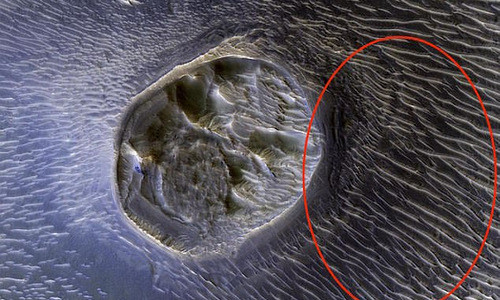NASA announced the most bizarre crater on Mars
The image of the Noctis Labyrinthyus crater, announced by NASA, is believed by many to be the ventilation roof of an underground city on Mars.
Noctis Labyrinthyus is an area known for its honeycomb-like structure on Mars. But a researcher thinks it's not just clusters of rocks and dunes, according to Brief Report.

The area that Warning says is a ventilation roof.(Photo: NASA).
The US Aerospace Agency (NASA) has published images taken with Mars explorers (MRO), highlighting the area between Valles Marineris and Tharsis plateau. NASA said that this structure may have originated from exposed sediments during erosion. But skeptics say it is "the ventilated roof of an underground city" , built by aliens.
Noctis Labyrinthyus (Night Labyrinth) once impressed scientists with a deep valley system, possessing many lines similar to labyrinths. The photograph of Noctis Labyrinthyus was recorded by MRO with HiRISE camera since 2006. The researchers confirmed that this structure was generated by the fracture process, but expert Scott C. Warning believed that they were built by aliens. .
The walls have a height of 1-30m, in the middle of them have the same structure as the food filter of the whale.
He thinks this is a city created by little aliens. Warning affirms that the ventilation roof is necessary to combat the harsh environment on Mars, as well as to help improve the temperature of the city. This observation received support from some people, but most scientists rejected the hypothesis of Warning.
- See the sharpest color photos of Mars
- NASA discovered giant ice on Mars
- NASA: Use robots to explore the crater on Mars
- Close up of the largest crater on Mars
- NASA discovered deep holes on Mars
- NASA announced the real picture of the landfall in the movie about Mars
- Beautiful images are only available on Mars
- The Mars probe arrived at the crater Endeavor
- The 1500km volcanic crater on Mars may have life
- Mars exploration robots will land harassment
- The crater lake on Mars changes shockingly
- Latest photos of scenes never seen on Mars
 Van Allen's belt and evidence that the Apollo 11 mission to the Moon was myth
Van Allen's belt and evidence that the Apollo 11 mission to the Moon was myth The levels of civilization in the universe (Kardashev scale)
The levels of civilization in the universe (Kardashev scale) Today Mars, the sun and the Earth are aligned
Today Mars, the sun and the Earth are aligned The Amazon owner announced a secret plan to build a space base for thousands of people
The Amazon owner announced a secret plan to build a space base for thousands of people